Drainage device around the house: design and installation of a drainage system with your own hands
The drainage system is designed to protect underground structures from groundwater. It is needed in areas with complex hydrogeological conditions, among which we have the majority of land plots.
Timely drainage around the house will extend the life of the foundation, save you from perpetual repairs. It’s cheaper to prevent the destruction of the building’s foundation than to restore it endlessly, do you agree?
How to organize drainage around a private house, you will learn from the article. A detailed description of the varieties and principles of operation of the drainage system will help determine the optimal version of the device. Using the proposed information, you will be able to build a workable network for the removal of underground water.
The owners of the plots who wish to independently construct a closed drainage will find a detailed description of the technology and a step-by-step summary of the sequence of work. The text part is supplemented by photo confirmation and video instruction.
The content of the article:
Reasons for organizing a drainage system
A special system of drainage pipes or channels is arranged so that as much moisture as possible gets inside and moves to a safe distance from the house or other buildings. The problem of the effect of moisture on the foundation is usually characteristic of clay soils: sandy loam, loam, clay.
In an area dominated by clay rocks in the section, water is slowly absorbed or does not leave at all. Due to stagnation of water, the base of the house is destroyed. The existing waterproofing protection of the foundation may be insufficient, on it may be weakly glued seams, areas untreated with mastic.
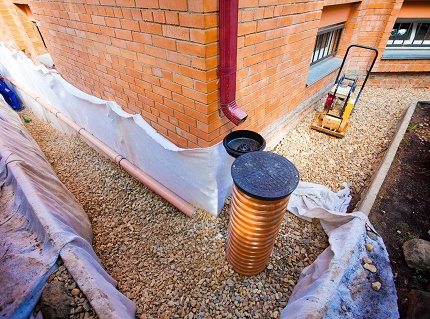
As a result, mold, fungus occurs on the concrete monolith, corrosion on the reinforcement, which in the future often becomes the cause of the destruction of the foundation.
On sandy, well-permeable soils, moisture goes away faster, so this kind of problem occurs less often. But still, the owner of the house should not relax and rely on “maybe” in this matter.
Excessive wetting of the structure can be caused not only by the characteristics of the soil, but also by other features of the site. For example, a high level of ground water, which prevents the seepage of moisture from the overlying layers down.
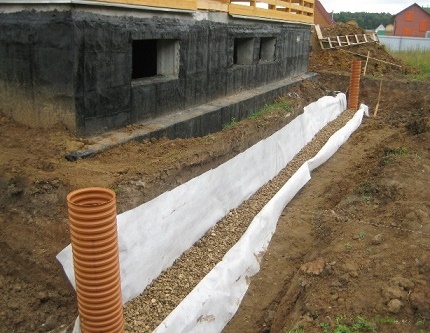
If the bottom of the wall after rain is covered with wet spots for a long time, this indicates that you need to think about the need for drainage facilities. Wet walls in the basement, the presence of mold or fungus shows that the drainage problem on the site should have been dealt with yesterday.
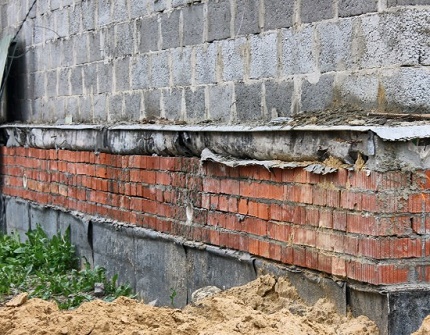
Even a very good waterproofing of the foundation eventually deteriorates. This is another reason to take care of good drainage near the house. The smaller the impact of groundwater on the structural parts of the structure, the less often will require large-scale work to restore the waterproofing layer applied to the foundation.
If the collection and disposal of ground and flood water were not provided for at the construction stage, after construction it is possible to take care of the drainage around the house and its construction with your own hands.
Typical types of drainage
There are several basic drainage systems with which you can collect and remove unnecessary moisture from the house and from the site. With proper design and installation, each of them demonstrates a fairly high efficiency, but the cost of time, effort and money depends on the complexity of the design.
There are three options for organizing a drainage system:
- open
- filling;
- closed.
Open drainage systems are ditches with a depth of about 50-70 cm and a width of the order of half a meter. Such ditches were dug around the house is not a problem, but the landscape will noticeably suffer from this. And jumping all the time through the recesses surrounding the house is not very convenient.
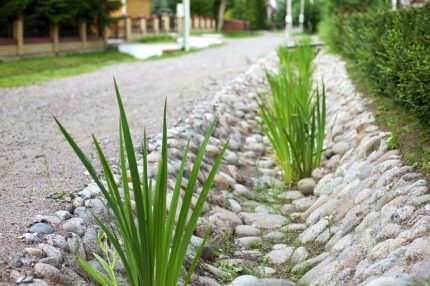
Outdoor drainage is usually covered with neat decorative grilles. They protect the structure from large debris and blockages caused by it. And such grooves with gratings look more aesthetically pleasing.
Filling drainage systems They are approximately the same ditches, only they are not covered with protective grilles, but they are covered with moisture-permeable material, for example, large gravel, broken brick or gravel. It is not so difficult to arrange drainage of this type, and the costs will be quite moderate.
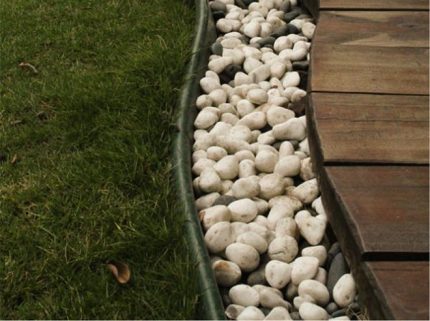
Before starting work, you need to mark and carefully cut the sod at the site of excavation. The ditches do not fall asleep, so that there is little space left.
The turf stored for these purposes is laid on top of the backfill to minimize damage to the site landscape. It is recommended to lay a geotextile layer at the bottom of the ditch to extend the life of the structure.
This version of the drainage system has some drawbacks: it is harder to clean than an open system. Of course, garbage getting into such a drainage is unlikely, but there remains the problem of siltation of the contents of the ditches.
If the efficiency of moisture removal decreases markedly, you may have to remove the sod again, completely replace the filler, and then return the system to its previous state.
Indoor drainage the most difficult to install, but at the same time it is reliable and has a long service life. A layer of gravel or similar materials is laid in the drainage ditches, pipes with a perforated surface are installed on top.
Plastic constructions are usually used, they are cheaper, weigh less and perforation is easier on their surface than on metal counterparts.
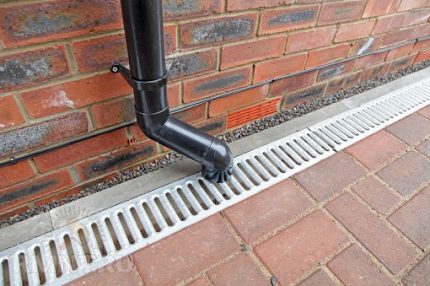
Closed drainage systems are most conveniently mounted along the curb of the paths surrounding the house. Here, the whole system will be reliably hidden and will not affect the appearance of the site at all. There is also such a thing as wall drainage.
He is satisfied with the process of building a house in those cases when it is planned to build a basement or basement. Drainage pipes are laid directly in the pit under the foundation near the walls, and then all this is covered with filter material and soil.

Another important element of the system is storm drainage. These are open trays that are designed to collect and transport water collected from the roof and blind areas of the house during rain. Storm drainage can also be open and closed; it is usually installed under drainpipes connected to gutters and funnels.
Features of the organization of drainage of the garden plot are detailed in this article.
Groundwater drainage system design
Of course, the drainage system consists not only of pipes and trays. To monitor the state of the system, inspection wells are needed, and a drainage well should be arranged in which this excess moisture will be discharged. For this reason, the ditches into which the pipes are laid give a slight slope towards this well.

It makes sense to consider the installation procedure for a closed drainage system, since it is the most difficult to implement. An open and backfill option can be arranged based on the same principles.
Closed system pipes are laid around the perimeter of the building at a distance of 0.7-1.0 m from it. By analogy, grooves are formed for the open and backfill drainage scheme.
At each corner where the trench is turning, be installed manholes. In advance, it is necessary to determine the location of the collector well into which the discharge of water will be discharged.
If water collection is intended to be off-site, then arrange a drainage well. Another pipe is laid from it, which usually goes to the roadside ditch. You can also tap to the local reservoir, if any, in the immediate vicinity of the house.
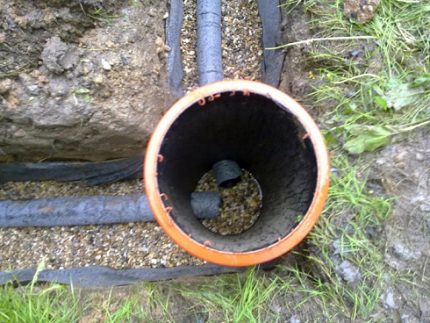
The depth of the trench under the closed drainage depends on the size of the foundation. Pipes should be laid 50 cm deeper than foundation slabs. At the same time, the bias of communications should be 0.7-1%.
Do not lay pipes with a large slope, as this can cause blockages. A small slope is also not recommended, as this will adversely affect the process of moisture removal.
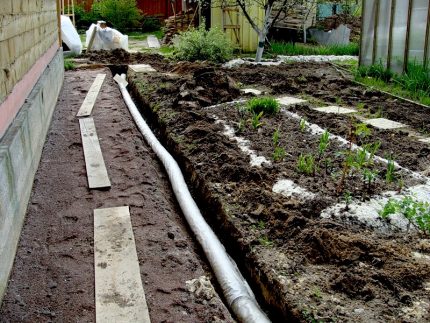
The width of the trench should be 20 cm larger than the diameter of the drainage pipe: 10 cm of clearance on each side. The location of the drainage system should be schematically reflected on paper, indicating all its elements. This will allow you to calculate the length of communications, as well as the number of additional elements necessary for the correct installation of the system.
Features of the closed option
Having figured out how to properly drain around the house, and having prepared the project, you should prepare for further work. You should stock up on materials, as well as the right tools.
In the course of work, you may need:
- twine for marking and marking the position of communications;
- construction level and plumb to control pipe slope;
- bayonet and shovel;
- tool for tamping soil;
- a bucket and / or wheelbarrow for transporting unnecessary land;
- tape measure to take measurements;
- hacksaw for metal, etc.
You will also need a certain amount of drainage pipes. These are special constructions with perforation, usually they are made of plastic. Instead, you can use plastic pipes for external sewagehaving previously done holes on their surface with an ordinary drill.
Additionally, it is necessary to prepare: geotextiles, sand, gravel or other similar material, manholes by the number of turns, etc.
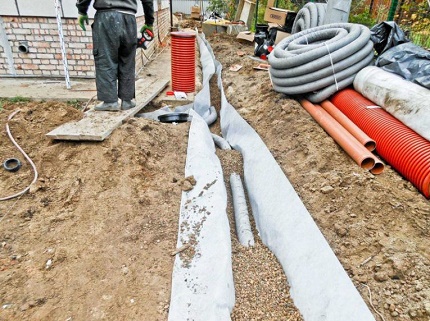
Geotextiles are necessary in order to protect the filler surrounding the drainage pipe from the penetration of fine clay particles and siltation. Saving on this material is not worth it.It should be enough to completely cover the walls and the bottom of the dug trench, as well as cover the bombarded pipe with a solid overlap.
First, it is recommended to mark on the ground, and then proceed with earthwork. Usually they begin to dig from the highest point of the system, gradually deepening the trench.
When calculating drain pipe slope You can focus on the norm of 1%. If the length of the trench is 20 m, then the height difference between its start and end point should be 20 cm. The necessary measurements are carried out using an ordinary tape measure.
After the trench is ready, its bottom must be carefully tamped. Then a 10 cm layer of sand is poured into the bottom, which is also carefully compacted. After that, it is recommended to cover the entire trench with a layer of geotextile so that both the bottom and walls of the structure are covered, and the edges of the material come to the surface and lie freely on the ground.
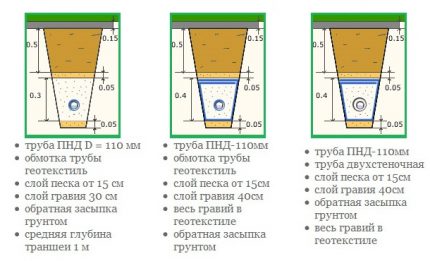
Now, on the bottom, hidden by geotextile, you need to pour a layer of gravel of about 20 cm. Any filtering material will be acceptable: crushed stone, expanded clay, fragments of brick, etc. The main thing is that its fraction be larger than the size of the holes in the drainage pipes, otherwise blockages cannot be avoided.
After laying, the gravel must be leveled and it is imperative to check the slope of the communications, it must correspond to the calculations and measurements made earlier.
If everything is in order, drainage pipes are placed on the gravel, connect them to the inspection and drainage wells. Then the system is covered with another layer of gravel (crushed stone, expanded clay, etc.). The height of this layer should also be 20 cm. The edges of the geotextile, which remain free, are wrapped over the backfill layer.
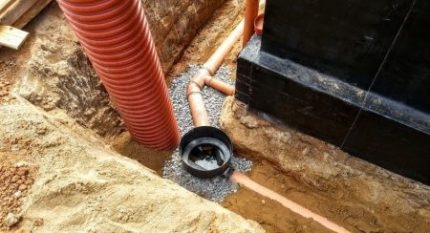
The overlap of the layers of nonwoven material should be about 30 cm. Sometimes it is recommended to fix the position of the geotextile with twine or plastic clips.
Now you can fill the rest of the trench with sand (you need a layer of 10 cm) and soil. The sand needs to be compacted again, especially in the space on the sides of the drain pipe. Stacked earlier sod is laid on top or tracks are mounted.
You can also come up with your own version of decorating the place for laying drainage pipes. Access must remain to the covers of the inspection wells, as well as to the point of discharge of the removed moisture.
Viewing wells are vertical plastic containers, covered with lids. They are used to periodically check the status of the system.
A drainage well is a wider capacity; it can be round or square in configuration. Most often, an old plastic barrel is used to equip it.
You can also use concrete rings of suitable diameter or make walls of monolithic concrete. In the latter case, reinforcement of the structure must be performed. The top of the drainage well should be closed with a strong cover.
Stages of building drainage around the house
The construction of a drainage system, designed at the stage of drainage and laid during the construction of the house, includes a number of standard stages following one after another:
Purpose of the blind area and its device
Supplementary drainage will also help protect walls and foundations from unnecessary moisture. blind area around the house. This is the name of the layer of waterproof material, which is laid along the walls with a slope outward. Precipitation, falling on the blind area, immediately flows away from the house, so the contact of the walls and the foundation with moisture will be minimal.
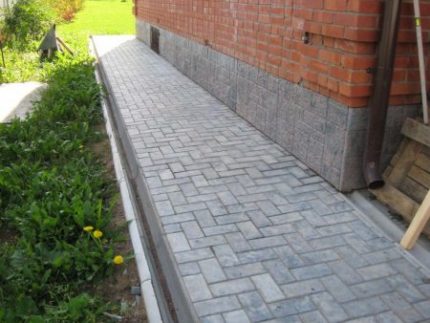
To perform the blind area, you can use the following materials:
- clay;
- a rock;
- paving slabs;
- asphalt;
- concrete;
- PVP membranes.
Installation of blind areas made of clay and stone, as well as from paving slabs, can turn out to be rather laborious, however, such a finish looks just fine. Asphalting and concreting will cost much cheaper, but it looks very modest, even utilitarian.
PVP membranes are mounted in the thickness of the soil, any convenient coating can be arranged on top: turf, tile, lawn, etc.
Conclusions and useful video on the topic
The procedure for doing home drainage at home is clearly presented in this video:
Interesting drainage tips can be found here:
The option of performing blind areas around the house:
Obviously, to protect the house from moisture, a number of measures must be taken, and the drainage system should be effectively combined with the blind area, stormwater, etc. In the future, all efforts will pay off, because the foundation of the house, its walls and the basement will not need repair for a long time.
Do you have personal experience with arranging drainage around your home? Want to share best practices or ask questions about a topic? Please leave comments - the discussion form is located below.

 Drainage scheme around the house: the nuances of designing drainage systems
Drainage scheme around the house: the nuances of designing drainage systems  Site drainage project: selection of location, slope, depth, drainage system elements
Site drainage project: selection of location, slope, depth, drainage system elements 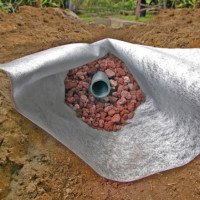 DIY drain pipe installation: step-by-step instruction + analysis of nuances
DIY drain pipe installation: step-by-step instruction + analysis of nuances 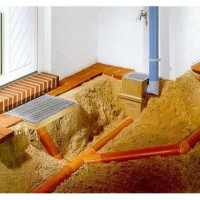 How to make your own foundation foundation drainage: step-by-step instruction on arrangement
How to make your own foundation foundation drainage: step-by-step instruction on arrangement 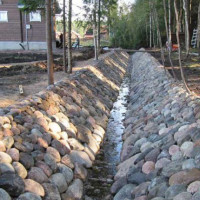 Slope of the drainage pipe: calculations, standards and features of the installation of drainage on the slope
Slope of the drainage pipe: calculations, standards and features of the installation of drainage on the slope 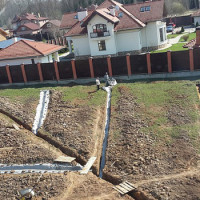 Do-it-yourself site drainage: features of the construction of various types of drainage
Do-it-yourself site drainage: features of the construction of various types of drainage  How much does it cost to connect gas to a private house: the price of organizing gas supply
How much does it cost to connect gas to a private house: the price of organizing gas supply  The best washing machines with dryer: model rating and customer tips
The best washing machines with dryer: model rating and customer tips  What is the color temperature of light and the nuances of choosing the temperature of the lamps to suit your needs
What is the color temperature of light and the nuances of choosing the temperature of the lamps to suit your needs  Replacement of a geyser in an apartment: replacement paperwork + basic norms and requirements
Replacement of a geyser in an apartment: replacement paperwork + basic norms and requirements